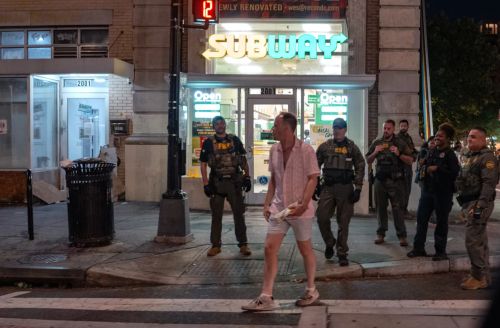

Civil disobedience has always been the pulse that reminds democracy of its conscience. It was the spark that lit the American Revolution itself.

By Matthew A. McIntosh
Public Historian
Brewminate
Introduction
Civil disobedience has long been the conscience of American democracy, the moral brake applied when legality and justice fall out of sync. It is the act of saying “no” when the law demands silence, and “enough” when power demands submission. From Henry David Thoreau’s refusal to pay taxes supporting slavery to the civil rights sit-ins of the 1960s, disobedience has marked not the failure of order, but its redemption.
That legacy now returns to the center of national debate as President Donald Trump’s administration tightens its grip on dissent. Across the country, protesters, journalists, and faith leaders face escalating restrictions, while federal agencies expand surveillance and policing under the banner of “domestic stability.” In this climate, resistance through lawful petition is increasingly met with hostility, and nonviolent disobedience has reemerged as a language of citizenship.
Political theorist Hannah Arendt saw civil disobedience as not merely a right but a duty within democracy: a mechanism to restore legitimacy when leaders abandon moral restraint. Her warning feels prophetic. Trump’s blending of state power and personal vendetta has pushed civic life toward a threshold where obedience itself becomes complicity.
This article explores that threshold, how the concept of civil disobedience, from Thoreau to Arendt, is being reclaimed in modern America as a counterweight to authoritarian ambition. It examines how citizens and communities are rediscovering nonviolent resistance not as rebellion, but as repair, a reassertion of the people’s role in defining the limits of power.
The Theoretical Foundations of Civil Disobedience
Civil disobedience has always occupied the fragile space between law and conscience, a deliberate act of tension meant to expose the moral limits of authority. In democratic societies, it functions not as anarchy, but as accountability. Philosophers from Socrates to Thoreau argued that obedience to law cannot be absolute, for when law becomes a tool of injustice, refusal becomes a higher form of loyalty to truth. In that spirit, Thoreau’s 1849 essay Civil Disobedience did not merely advocate protest; it demanded personal responsibility for the moral consequences of complicity. His refusal to pay a poll tax that funded slavery was a declaration that silence in the face of injustice is itself a form of violence.
In the twentieth century, that idea matured through figures like Mahatma Gandhi and Martin Luther King Jr., who transformed civil disobedience from an individual act into a collective ethic. King’s insistence that “one has a moral responsibility to disobey unjust laws” established nonviolent resistance as a democratic practice rather than a disruption of it. The method was not to destroy institutions but to expose hypocrisy, to make visible the gap between the ideals of equality and their betrayal in practice. That gap, King understood, could only be bridged when citizens withdrew their consent from injustice.
Political theorist Hannah Arendt expanded this understanding, reframing civil disobedience as an institutional necessity within democracy. Arendt viewed disobedience not as deviance but as a stabilizing force, a reminder that the vitality of democracy depends on citizens willing to act when formal mechanisms fail. In her view, civil disobedience was not rebellion against law but a form of participation in its renewal. When governments grow insulated from accountability, she argued, dissent becomes the last functioning check on power.
That principle resonates deeply in today’s United States. Under Trump’s administration, law is increasingly wielded as a weapon against opposition, from punitive immigration raids to federal crackdowns on protest movements. In such a climate, Arendt’s warning rings with urgency: when obedience serves the powerful rather than the just, the obligation of conscience shifts. Civil disobedience becomes a civic act, not to overthrow democracy, but to reclaim it from those who mistake authority for legitimacy.
Civil disobedience, then, is not chaos but conscience organized. It embodies the paradox that democracy requires both consent and resistance, that the health of a free society is measured not by the absence of defiance but by the integrity of those who dare to disobey unjust command. In the words of Thoreau, “Under a government which imprisons any unjustly, the true place for a just man is also a prison.” Today, that sentence reads less like metaphor and more like instruction.
Civil Disobedience Confronting Trump’s Authoritarian Tendencies
In the current political landscape, civil disobedience has become not only a moral stance but a strategic necessity. Trump’s second administration has blurred the distinction between governance and domination, treating dissent as disloyalty and protest as subversion. His calls for “total enforcement” and “domestic order” have translated into an expansion of executive power that increasingly targets civic activism and opposition media. The response has been the reawakening of a distinctly American tradition: organized, nonviolent refusal to cooperate with unjust authority. In some cases, citizens have directly confronted that authority unlawfully while being willing to accept the consequences, the very definition of civil disobedience. Sean Charles Dunn, a former paralegal with the Department of Justice, threw a sub sandwich in protest at a Border Patrol agent. He was arrested and prosecuted. A jury recently found him not guilty in a clear case of nullification, validating his act of civil disobedience. While it was technically “violent” and legally assault, the jury excused the action.
Trump’s authoritarian instincts have unintentionally revived the philosophy of Henry David Thoreau. The same logic that once inspired abolitionists and suffragists now fuels modern movements that see noncooperation as both a right and a responsibility. From immigration attorneys refusing to participate in mass deportation hearings to federal employees leaking evidence of abuse, the resistance often takes quiet, disciplined forms of defiance rather than spectacle. It is a reminder that civil disobedience need not always fill the streets, sometimes it simply means refusing to lend legitimacy to injustice.
Yet the streets remain a vital arena. In cities such as New York, peaceful demonstrators have staged coordinated disruptions outside immigration courts and detention centers, resulting in mass arrests. These actions, though symbolic, serve a deeper purpose: to force public recognition of state power being exercised without moral restraint. Each arrest, each banner held aloft beneath the courthouse steps, reasserts the principle that conscience cannot be legislated away. George Bottger, a U.S. Navy veteran, wrote that we must follow the example of John Lewis in making “good trouble” and added, “The only way I see this happening is through massive, non-violent protest and selective civil disobedience…When they come to town, everybody who is capable must show up and surround them, making it as unpleasant, inefficient, and time-consuming as possible for them to snatch people off the streets or from their homes.”
Grassroots movements have extended far beyond progressive enclaves. Resistance networks are emerging even in conservative strongholds once considered immune to protest culture. Faith groups, educators, and veterans in small towns have organized vigils, boycotts, and acts of noncooperation, defying the caricature that opposition to Trump’s authoritarian drift exists only in coastal cities. This decentralization of dissent represents a powerful evolution of civil disobedience: local, disciplined, and often rooted in shared moral language rather than partisan identity.
Civil disobedience in Trump’s America thus functions as both mirror and counterweight. It reflects the reality of a nation where the rule of law has been selectively applied, and it challenges that imbalance through principled refusal. Noncooperation is not chaos; it is the disciplined practice of freedom. Against a presidency built on coercion and fear, that discipline may prove to be the truest measure of citizenship.
Limitations, and Strategic Considerations
Civil disobedience has always carried risk, but under President Trump’s increasingly punitive administration, those risks have multiplied. Protesters face enhanced federal charges, expanded surveillance, and in some cases, military-style policing. Trump’s rhetoric, branding dissenters as “domestic threats” or “traitors,” creates an atmosphere in which nonviolent resistance can be reframed as sedition. That shift does more than endanger activists; it distorts the public’s moral compass by equating obedience with patriotism and conscience with crime.
Still, history suggests that the moral power of civil disobedience lies precisely in its willingness to bear the cost of truth. The arrest of peaceful protesters at New York’s immigration court reflects this enduring principle. Each act of voluntary suffering forces the state to reveal its character, whether it seeks justice or submission. In Arendt’s terms, disobedience creates a mirror in which authority must see itself. Trump’s administration, by responding to peaceful dissent with force, exposes the authoritarian impulses it insists do not exist.
Yet nonviolent resistance must evolve alongside repression. Scholars from the Hannah Arendt Center at Bard College have argued that modern civil disobedience requires structure and discipline equal to that of the power it opposes. It cannot rely solely on spontaneity or outrage; it must build networks capable of sustaining pressure without succumbing to fatigue or fragmentation. Under Trump, where the machinery of surveillance and propaganda is highly coordinated, disobedience must likewise be strategic, anchored in shared purpose, transparent ethics, and public solidarity.
There are limits, too. Civil disobedience alone cannot dismantle authoritarianism; it can only reveal its nature and awaken the public conscience against it. Without institutional support (from courts, faith groups, journalists, and legislators) nonviolent resistance risks isolation or co-option. But when fused with civic infrastructure, its power multiplies. The quiet courage of ordinary citizens refusing to cooperate with oppression remains one of democracy’s last reliable defenses. The danger of Trump’s America is not that people will resist; it is that they will stop believing resistance matters.
Conclusion
Civil disobedience has always been the pulse that reminds democracy of its conscience. It was the spark that lit the American Revolution itself. Under Trump’s authoritarian reach, it has once again become the measure of our nation’s moral health. The refusal to cooperate with injustice, whether through public protest, professional noncompliance, or local acts of resistance, is not rebellion against America, but fidelity to its founding promise. Observed through Hannah Arendt’s work, the vitality of a republic depends on citizens who can say no when the law betrays justice. Without such refusal, democracy becomes obedience disguised as order.
The tradition endures precisely because it is nonviolent. It demands no conquest, only conscience. Thoreau’s legacy reminds us that moral clarity often begins in personal defiance, one citizen refusing to cooperate with wrong. Under Trump’s administration, where intimidation and fear are wielded as instruments of governance, that individual act of courage ripples outward. From the clergy who open their sanctuaries to migrants, to the journalists who refuse to normalize propaganda, civil disobedience becomes a quiet chorus of integrity in a government of noise.
In the end, the power of civil disobedience lies not in breaking laws, but in revealing which laws, and leaders, have already broken faith. The choice facing Americans today is not between chaos and control, but between obedience and conscience. Authoritarianism thrives on silence; democracy survives on dissent. And in an age when truth itself is on trial, civil disobedience may be the last honest defense left.
Originally published by Brewminate, 11.20.2025, under the terms of a Creative Commons Attribution-NonCommercial-NoDerivatives 4.0 International license.


